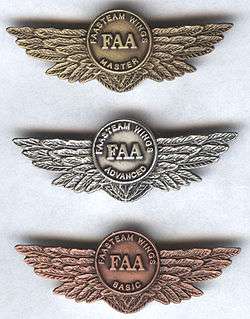Pilot Proficiency Award Program
The US FAA's Pilot Proficiency Award Program (Wings) promotes air safety and encourages general aviation pilots to continue training and maintain proficiency. All of this in an effort to prevent aircraft accidents. The program features two aspects, knowledge and flight. The knowledge portion presents on line courses to maintain or increase an airman's knowledge. The courses are at a quality level found in college, air carrier or military education presentations. The flight portion provides an opportunity to practice and perform selected maneuvers to the standards found in the FAA Flight Test Guide for the certificate level you hold or choose to exercise. (Example: A retired airline pilot with an Airline Transport Pilot certificate may elect to perform at the Private Pilot level for the purposes of satisfying the Wings Program requirements.)
The Program is available to all through the FAA Safety Team Web site; knowledge provided through the program is free of charge.
Proficiency phases
- Basic
- Advanced—For those who wish to maintain a higher level of proficiency than required by the Basic level.
- Master—For those who wish to maintain the highest level of proficiency.
Legacy program


As laid out in Advisory Circular 61-91H,[3] (obsolete, superseded by AC61-91J) the program offered twenty phases and offered you a twenty-year recurrent training opportunity. Participants were eligible for more wings every year after earning their first set, each added set marking progress.
From the program's inception in 1996 until 2007, each of the first 10 phases of the program awarded a pin and a certificate.
- Phase 1 wings are plain bronze color.
- Phase 2 wings are silver color with a star added.
- Phase 3 wings are gold color with a star and wreath.
- Phase 4 wings are gold tone and have a simulated ruby mounted in the shield.
- Phase 5 wings are gold tone with a rhinestone mounted in the shield.
- Phase 6 wings are gold tone with a simulated sapphire mounted in the shield.
- Phase 7, 8, and 9 wings are gold tone with the appropriate Roman numeral displayed within the wreath.
- Phase 10 wings are bright gold tone with the Roman numeral X and shield located within a ring of 10 stars.
Past phase 10, only a certificate is awarded.
Seaplane pilots who specify “seawings” on the proficiency award application get a distinctive set of seawings.
Program updates

The original Wings program was updated in 2007.[4] It was replaced by a new program from the new FAA.[5] This new program attempts to provide better standards for pilots getting flight reviews and training, adding the most common causes of accidents into the curriculum and providing set standards for maneuvers, instead of giving a minimum flight time to complete.
While the FAA does provide pins for completion of a level of the new Wings program under the updated program,[6] it has entered into a partnership with aviation insurer Avemco where is announced that Avemco will continue to sponsoring the WINGS Pilot Proficiency Program by supplying all WINGS participants with WINGS lapel pins upon program completion.[7] The FAA does however intend to keep track of a pilot's recurrent training and will be able to remind the pilot by e-mail if their training is close to expiring, requiring them to get a new flight review or complete another Wings course via a website link.
On 24 September 2010 the program was further updated to include specific recognition for those sea-rated pilots who complete a phase of WINGS in a seaplane or amphibian. The Seaplane Pilots Association agreed to send a lapel pin to these pilots, and some insurance companies have started to offer "significant premium discounts" to members of the Association who complete a phase of WINGS in a seaplane.[8]
References
- ↑ FAA Advisory Circular 61-91J
- ↑ FAA Order 8900.1, Flight Standards Information Management System (FSIMS),Volume 5, Chapter 2, Section 11
- ↑ "Pilot Proficiency Award Program" (pdf). Federal Aviation Administration. April 26, 1996.
- ↑ FAA Website describing the changes
- ↑ safety website
- ↑ FAA on-line tutorial describing new program
- ↑ Avemco press release - AVEMCO ANNOUNCES SUPPORT FOR GENERAL AVIATION PROGRAMS FAA WINGS Program, AERI Research and Build A Plane to Benefit
- ↑ FAASafety.gov - "Sea WINGS" notice